We were working hard this Toronto Fringe, taking in a total of 16 plays ranging from dance to drag to one-man displays or neurosis. There were companies of one, companies of ten, staged readings, fully-mounted musicals, lots of laughs, a couple of tears and grades ranging from A to D. Read on for all the productions that scored within the ever-popular B-range, from the so-so to the pretty darn close to fantastic.
 Chaotica
Chaotica
Grade: B-
The first single-performer show on my schedule, Chaotica proved an excellently entertaining introduction to the world of quirky energetic lunatics I would be living in for the coming weeks. One-person shows abound at Fringe (a lot of times for simple budget reasons) and I’ve never seen a bad one. Chaotica, for its part, though very clever at times (the audience participation husband search was my personal favourite) was a bit disjointed with an unclear purpose or mythology. I get that it was about chaos, but board games have rules and this one didn’t seem to have a purpose let alone make much sense. There was a nice little bit of poignancy when she gathered the courage to jump out of the game at the end but for the most part Chaotica was nothing more or less than a fun, entertaining and largely shapeless hour of energetic theatrics.
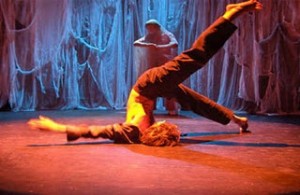 Let’s Play House
Let’s Play House
Grade: B-
One of the more interesting aspects of a jam-packed Fringe week is the sense of bizarro community. The same faces pop up over and over again in line, you end up riding the streetcar from theatre to theatre with erstwhile strangers and the braintrust of amateur reviewers offers an unending supply of suggestions and warnings about the shows they’ve already seen. It was this strange reality that led me to Let’s Play House. There was a woman I’d met in line 3 or 4 times who didn’t speak particularly highly of many things. She liked everything alright but it was tough to really impress her. She had, however, seen Let’s Play House and had since been telling everyone she could find that it had opened her eyes and changed her life. As we waited in line for Mickey and Judy (review to come), we ran into one of her new heroes in the form of Jonathon Neville- one of the creators of the piece. He was so personable and sweet that his impression alongside her review dared me not to see the dance-based production (for the record, I wasn’t going in the first place because dance isn’t my strong suit for informed reviewing). Upon seeing it, I completely understood how Let’s Play House could change someone’s life; I saw how it was changing Jonathon’s and that of his fellow dancer and co-creator Carlynn Reed. The show took a sort of free-form approach to story-telling through acting and dance. Both dancers played themselves helping the other, themselves telling their own story, and the supporting character in each other’s story (his mother, her son). It flowed freely from scene to scene with only a shawl to help keep straight who was who at any given moment. A brilliant idea with some truly exceptional moments, Let’s Play House was a piece that I wish I had enjoyed more. But alas the actual performance itself grew tedious for me, repetitive and a bit long. The play itself gets the B- I’ve assigned; but the courage and dedication of Jonathon and Carlynn, their creativity, the ideas and stories behind the piece and that moment when her son Kirk was introduced as the fully functional sound board operator- those things deserve an A.
 Love, Virtually
Love, Virtually
Grade: B
If you review long enough, eventually you start to recognize the performers- get to know them through interviews and emails, or create an idea of who they are from who’ve they’ve played. Eve Wylden is a prime example. A principal member of one of my favourite companies, The Red Light District, I’ve seen Eve in multiple productions and interviewed her for last year’s My Theatre Award Nominee Series (she was up for best actress in the independent division). But her Fringe show this year was a bit of a departure for the familiar actress. Unlike standard RLD fare, Working Title’s Love, Virtually was fluffy and earnest. Don’t get me wrong, it was a lot of fun (much more up my typical alley) and Eve retained her comic quirk, it just wasn’t what I was expecting when I learned she was in it. The script was clever but needed some more polish- a rewrite or two and playwright Chloe Whitehorn could really have something good. I wasn’t as invested in Bunmi Adeoye’s central character of Laurel as I would have liked and there were some actors who were a bit static. Krista Barzso was the best actress as the tough but silly music agent and Alan Norman held down the emotional story with an engrossing performance as the lovelorn Matt. Most of the cast was made up of cute and charming men who played the guitar. Really. The endearing Nick Stojanovic maybe wasn’t the most natural actor but it was easy to forget that when he smiled really brightly; Joshua Wiles was really funny and likable as hell with his hipster musician routine and Michael Donnelly perfectly sold the meet-cute on the street corner that contradicted the entire piece, wrapping it up in its nice little romantic comedy bubble of “who cares, it’s pretty!”-ness. More than anything Love, Virtually was charming. Not to belittle or anything, but it was cute boys with guitars; not that there’s anything wrong with that.
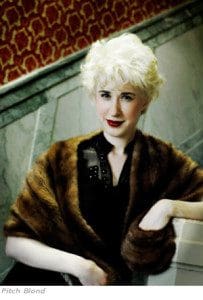 Pitch Blond
Pitch Blond
Grade: B
When I walked out of Love, Virtually, the older woman behind me said “I’m not sure I really understood that” because she was a member of entirely the wrong generation to have understood most of the subject matter. Now, I’m a well-educated person with a keen knowledge, specifically, of film and television history. But I’m just not quite old enough to have fully appreciated Pitch Blond. I could see very clearly how nuanced Laura Anne Harris’ performance was as helium-voiced Oscar winner Judy Holiday, a genius relying on her dumb blond movie persona to get her through the performance of a lifetime- testimony in front of McCarthy’s Communist-catchers. The performance was wonderfully complex, layered, surprising- all the good adjectives to throw at an actress, especially in a one-woman show (easily the most ambitious of all the single-performer pieces I saw). But I just couldn’t connect. I knew the history but I never knew the fear, the helplessness, the intensity of the time. And as wonderful a character as Harris created, she couldn’t pull me in far enough to really get it.
 When Harry Met Harry
When Harry Met Harry
Grade: B
They start get tedious after awhile, to be completely honest. When Harry Met Harry is yet another solid one-man show. It’s smart, it’s funny, it’s not entirely devoid of depth, it’s entertaining enough. Just like all the others. Allan Girod is truly excellent as Harry and as the self-help guru who tortures him. The characters are distinct, funny and wonderfully detailed. His dry interactions with audience members (including the unfortunate fellow chosen as that night’s “Bradley”) are wonderful and Harry’s fear is palpable as he works through his issues. The play isn’t as emotionally resonant as I would have liked but the performance is strong and the hour solidly entertaining. But it’s in no way anything truly new, which is too bad, because I really did like it. I do wish I had more to say but alas Harry didn’t really.
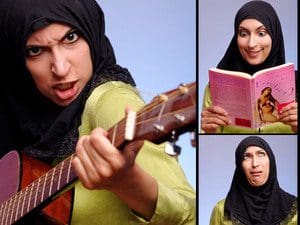 Headscarf and the Angry Bitch
Headscarf and the Angry Bitch
Grade: B+
Zehra Fazal is one hell of a performer. She’s dynamic and funny and frank and her one-woman show is simply great. Perhaps the fastest hour I spent at the Fringe, Headscarf was so entertaining that I had very few gripes. The first was the hair clearly spottable out the back of Fazal’s hijab; if it was fake, the hair gave her away, if it was real, then she has a bigger problem since I’m sure I’m not the only one who noticed. My only other issue was less technical and a lot more important. The piece is written as the story of a Muslim woman from the American south on tour in New Jersey. But this ain’t Jersey. Jokes that land south of the border aren’t as funny in the multi-cultural metropolis of Toronto and Fazal couldn’t count on the ignorance of her audience the way she seemed to want to. One of the great things I remember about the Canadian premiere of the musical Bare was that the Torontonian director had a real sense of where he was when staging the American-written story about gay teens; it’s just slightly different- not a lot, but enough to make a bit of a difference. Fazal’s story was very much about an American Muslim. My point is less about country than it is about demographics; the audience of a Fringe show in downtown Toronto in 2011 who voluntarily signed up to see something called Headscarf and the Angry Bitch might not be the same demographic as the New Jersey YMCA. That said, I will answer silly “haram or halal” questions about skittles any day in exchange for another rendition of Fazal’s “We Didn’t Start the Fire” interpretation including the ingenious line: “Well, if I’m haram well then so’s your mom!”
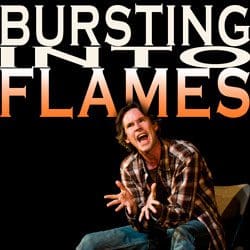 Bursting into Flames
Bursting into Flames
Grade: B+
At the end of a standard Fringe show, the performers remain on stage to plead for word of mouth and plug other shows. At almost everything I went to, someone mentioned the genius of Martin Dockery, his success in 2009 with Wanderlust and the fact that his new show Bursting Into Flames was not to be missed. So I made a point of not missing it. I didn’t know a thing about Dockery going in except that I’d just sat beside him at The Progressive Polygamists (review to come) and he’d seemed a quiet, self-contained, normal guy. So obviously there was nothing that could prepare me for his one-man show- less of a show than a supersonic rant accompanied by wild gesticulations and comic timing that’s been heretofore unrivaled. But as exuberantly enthralling as his performance was, it’s Dockery’s writing that really separated Bursting Into Flames from the many other excellent single-performer shows at the Fringe. It was clever, inventive, thoughtful and wonderfully honest considering it was about the unknowable and unrelatable afterlife. Bursting Into Flames was a darkly comic, enthralling, enlightening and fascinating exploration of the tortures of utopia. A real achievement from paper to presentation.
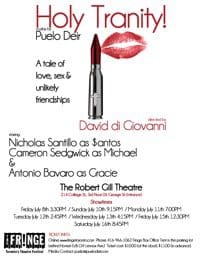 Holy Tranity
Holy Tranity
Grade: B+
I picked Holy Tranity almost at random from the Fringe guide. I thought it looked like an interesting story, so I went. When I arrived at the Robert Gill Theatre I was disappointed to find that what I’d bought a ticket to wasn’t a real play but a staged reading. What I didn’t anticipate was that that staged reading would be more moving and truthful than almost any fully-staged production I saw. Set at a gay strip joint with promotional materials campier than an episode of Ru Paul’s Drag Race, Holy Tranity undersells itself. Behind all the flash, it’s a heartbreaking story of a young gay man named Santos and the two men who help him find himself. The script by Puelo Deir is technically still in its development stages (hence the reading) but its present form proved as tight as any I heard at the festival. The exceptional cast gave wonderful life to Deir’s characters and their performances were whole enough that the audience not only got a sense of the characters and their dialogue but a real sense of the play as a whole, beyond its reading incarnation. The highlight was Antonio Bavaro who took on the crucial role of Gracie, the drag queen hostess at the bar and the narrator of the reading. Despite being long-haired and slight, other than a pair of high heel shoes, there was nothing about Bavaro that could confuse his gender. He was clearly a man and not an overwhelmingly effeminate one, as made perfectly clear when he opened the show with the voice of the DJ in a deep baritone. Bavaro then morphed before the audience’s eyes, letting down his curly hair and sinking into the most grounded cross-gendered performance I’ve ever seen. The confident character of Gracie brings with her a certain unmistakable fabulous flair, to which Bavaro did excellent justice without ever sacrificing the achingly real person behind Gracie’s trappings. There was so much warmth and compassion and strength to Gracie, the heart of the piece, that both Deir and Bavaro should be unendingly proud of their joint creation.
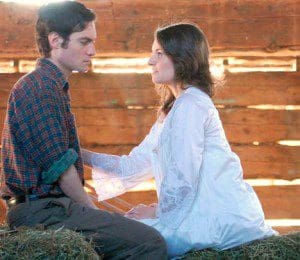 Mary’s Wedding
Mary’s Wedding
Grade: B+
The first production I saw at this year’s festival, I went because of my well-documented admiration for its leading man (My Theatre Award winner Jesse Nerenberg). I wasn’t disappointed. Jesse’s performance as WWI soldier/Canadian farmboy Charlie Edwards was charming and engaging. In fact, my mother came out of that theatre quite smitten with the young Mr. Nerenberg, wondering over and over again “how anyone could not fall in love with him”. That was, after all, the point of Mary’s Wedding. The inappropriately titled piece is actually about the ill-fated romance between Mary and Charlie (notably not the titular groom). The piece flits sporadically between their courtship and his experience in the war. Stephen Massicotte’s script is the let-down of the play, an unfortunately impossible obstacle for any production, it’s just too disjointed, strange and hard to follow. The actors did what they could to save it, however, creating enough fantastically memorable moments to earn themselves a spot relatively high in my Fringe ratings. Blythe Haynes started out slow as Mary, crippled by a truly terrible British accent (the lucky Nerenberg got to use his own Canadian dialect- a script-allowed but unfair advantage, truth be told). It wasn’t until Haynes took on the role of Charlie’s commanding officer Gordon Muriel Flowerdew that I began to see how wonderful she was. Her timing was flawless in her far-too-rare moments as Flowerdew and her physicality of the officer while trapped in Mary’s girlish dress was impressive. By the end of the play I’d grown to appreciate her take on the titular ingenue as well. Though she never quite stood up to Nerenberg’s grounding and energy, her grief in the final scenes was very affecting, taking me by surprise. It really is a shame that the shape of Mary’s Wedding wasn’t stronger because with more sturdy script support, Nerenberg and Haynes could have really flown.

